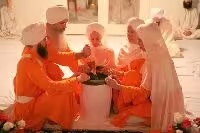Amrit Sanchar
Amrit Sanchar, also known as Khanda-ki-Pahul, is the profound Sikh ceremony of initiation or baptism. Rooted in the teachings of Guru Nanak Dev and formally established by Guru Gobind Singh in 1699, this ceremony marks the pivotal moment when individuals commit themselves to the Khalsa brotherhood, embracing a life of spiritual discipline, courage, and service. This comprehensive exploration delves into the historical origins, ritualistic intricacies, symbolic meanings, and contemporary relevance of the Amrit Sanchar within the Sikh faith.
Historical Origins:

The concept of water-based initiation, which represents spiritual rebirth, dates back to Guru Nanak Dev, the founder of Sikhism. This early tradition, known as Charan Amrit or Charan Phul, included pupils taking water from the Guru’s toe to symbolize their acceptance of his teachings and direction.
On Baisakhi Day in 1699, Guru Gobind Singh oversaw the transformation of this event at Anandpur Sahib. Guru Gobind Singh urged Sikhs to show courage and justice in the face of tyranny. Initially testing their determination, he eventually admitted the Panj Pyare—Bhai Daya Singh, Bhai Dharam Singh, Bhai Himmat Singh, Bhai Sahib Singh, and Bhai Mokham Singh—to the Khalsa fraternity via the Amrit Sanchar.
Ritualistic Elements of Amrit Sanchar:
1. Preparation and Participation: Prospective initiates (Amritdhari Sikhs) undergo rigorous preparation, including meditation (Naam Simran) and cleansing rituals (Ishnaan), symbolizing purification of the mind and body. Candidates commit to adhering to Sikh principles and preparing spiritually for their baptism.
2. Ceremony Conduct: Central to the Amrit Sanchar are the Panj Pyare, who play a pivotal role in preparing and administering Amrit. The ceremony typically takes place in the presence of Guru Granth Sahib, the holy scripture of Sikhism, revered as the eternal Guru. The Panj Pyare prepare Amrit, a sweetened water mixture, in a Sarb Loh (iron or steel) cauldron, symbolizing strength and resilience.
3. Baptism with Amrit: Initiates stand before the Panj Pyare, affirming their commitment to Sikh principles and readiness to embrace the Khalsa identity. The Panj Pyare recite the five Banis (Japji Sahib, Jaap Sahib, Sawayae, Chaupai Sahib, and Anand Sahib) from Guru Granth Sahib and Dasam Granth, infusing the Amrit with spiritual power and significance.
Each initiate receives Amrit in a specific manner: drinking it five times (Amrit Chhakhna), sprinkling it on their hair (Kesh), and in their eyes, symbolizing spiritual enlightenment and commitment to Sikh virtues.

Khalsa
The term “Khalsa ji” is commonly used to address individual Singhs or groups of them, but its more appropriate usage applies to the entire community or a representative assembly such as “Khalsa Panth” or “Sarbatt Khalsa.” In this context, “Khalsa” signifies the collective and spiritually-guided will of the community under the guidance of Guru Granth Sahib.
Following the establishment of the Khalsa in 1699, it was ordained as a community of saint-soldiers tasked with upholding the principles represented by the five symbols, known as Panj Kakka or the Five Ks:
Kesh: Uncut hair symbolizing the natural appearance of saintliness. Some argue for Keski, a small turban worn under a larger turban, which is seen as complementary to preserving Kesh.
Kanga: A small comb, emphasizing cleanliness and tidiness.
Kaccha: Warrior shorts symbolizing readiness and chastity.
Kara: A steel bangle symbolizing restraint, bondage to the Guru, and the removal of fear, as proclaimed by Guru Gobind Singh.
Kirpan: A sword representing dignity, power, and courage. The term “Kirpan” originates from “Kirpa” (act of kindness in Sanskrit) and “Aan” (self-respect in Persian).
Members of the Khalsa are required to live according to the teachings of the Guru, respecting Sikh principles while abstaining from non-Sikh religious rites and ceremonies, including the caste system. Sikh doctrine emphasizes equality among all community members, disregarding distinctions based on profession or social status.
To Summarize
Amrit Chhakhna (amrit sanchar) is viewed not as an endpoint but as the initiation into a lifelong journey towards spiritual purity and devotion. According to the teachings of Guru Granth Sahib, this ceremony marks the beginning of a path leading to union with God, emphasizing internal transformation over external rituals. The significance lies in embracing a righteous way of life that aligns with Sikh principles, fostering a deepened connection with the divine.
The belief is rooted in the understanding that the essence of Sikhism transcends mere external observances. Amrit Chhakhna symbolizes the commitment to embodying virtues such as compassion, honesty, and humility in daily actions. It serves as a pivotal moment where individuals pledge to uphold the teachings of the Gurus and contribute positively to society, guided by spiritual integrity and moral clarity.
Thus, Amrit Chhakhna (amrit sanchar) signifies not a culmination but a foundational step towards spiritual enlightenment and the attainment of God’s grace, reflecting Sikhism’s emphasis on inner spiritual growth and righteous living.
